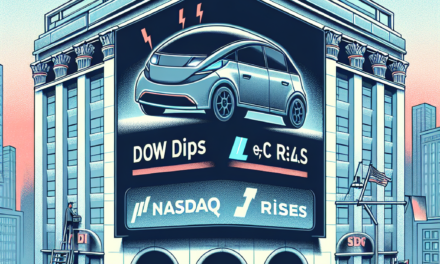“Driving Innovation Forward: Tesla’s Bold Vision for Q4 Success”
Introduction
In the final quarter of the fiscal year, Tesla has unveiled an ambitious strategy aimed at solidifying its position as a leader in the electric vehicle industry and expanding its market influence. This strategy focuses on accelerating production capabilities, enhancing technological innovations, and expanding its global footprint. By ramping up the output of its existing Gigafactories and investing in new facilities, Tesla aims to meet the growing demand for its vehicles while reducing production costs. Additionally, the company is set to introduce cutting-edge advancements in battery technology and autonomous driving features, reinforcing its commitment to sustainability and innovation. With strategic partnerships and a focus on entering emerging markets, Tesla’s fourth-quarter plan is poised to drive significant growth and set new benchmarks in the automotive sector.
Analysis Of Tesla’s Q4 Production Goals
Tesla’s ambitious fourth-quarter strategy has captured the attention of industry analysts and investors alike, as the electric vehicle giant sets its sights on achieving unprecedented production goals. As the year draws to a close, Tesla’s focus on ramping up production is not only a testament to its commitment to innovation but also a strategic maneuver to solidify its position in the competitive automotive market. This analysis delves into the intricacies of Tesla’s Q4 production goals, examining the factors that contribute to its ambitious targets and the potential implications for the company’s future.
To begin with, Tesla’s production goals for the fourth quarter are driven by a combination of internal and external factors. Internally, the company has been investing heavily in expanding its manufacturing capabilities. The recent upgrades to the Gigafactory in Nevada and the ongoing development of the Gigafactory in Berlin are pivotal in increasing production capacity. These facilities are expected to play a crucial role in meeting the heightened demand for Tesla’s vehicles, particularly the Model 3 and Model Y, which continue to be the company’s best-selling models. Moreover, Tesla’s focus on streamlining its production processes through automation and advanced manufacturing techniques is anticipated to enhance efficiency and output.
Externally, the global shift towards sustainable energy solutions has created a favorable environment for Tesla’s growth. Governments worldwide are implementing stricter emissions regulations and offering incentives for electric vehicle adoption, thereby boosting demand for Tesla’s products. In response, Tesla’s Q4 strategy aims to capitalize on this momentum by accelerating production to meet the increasing consumer appetite for electric vehicles. Furthermore, the company’s ability to navigate supply chain challenges, which have plagued the automotive industry, will be critical in achieving its production targets. Tesla’s strategic partnerships with suppliers and its efforts to localize production are expected to mitigate potential disruptions and ensure a steady flow of components.
In addition to these factors, Tesla’s ambitious production goals are also influenced by its desire to maintain a competitive edge in the market. As traditional automakers and new entrants alike intensify their efforts to capture a share of the electric vehicle market, Tesla’s ability to scale production rapidly will be a key differentiator. By achieving its Q4 targets, Tesla not only reinforces its reputation as a leader in the electric vehicle space but also positions itself to capture a larger market share. This is particularly important as the company prepares to introduce new models and expand its product lineup in the coming years.
However, it is important to acknowledge the challenges that Tesla may face in realizing its Q4 production goals. The ongoing semiconductor shortage, fluctuating raw material prices, and logistical constraints pose significant hurdles that could impact production timelines. Nevertheless, Tesla’s proactive approach to addressing these challenges, coupled with its robust financial position, provides a degree of resilience that may enable the company to navigate these obstacles effectively.
In conclusion, Tesla’s ambitious fourth-quarter strategy underscores its commitment to scaling production and meeting the growing demand for electric vehicles. By leveraging its manufacturing capabilities, capitalizing on favorable market conditions, and maintaining a competitive edge, Tesla is well-positioned to achieve its Q4 production goals. As the company continues to innovate and expand its operations, the implications of its success in the fourth quarter will likely extend beyond immediate financial performance, shaping the future trajectory of the electric vehicle industry.
Impact Of New Model Releases On Tesla’s Market Share
Tesla’s ambitious fourth quarter strategy has captured the attention of industry analysts and investors alike, as the company unveils plans that could significantly impact its market share. Central to this strategy is the release of new models, which Tesla hopes will not only bolster its position in the electric vehicle (EV) market but also expand its reach into new customer segments. As the EV landscape becomes increasingly competitive, Tesla’s ability to innovate and adapt is crucial for maintaining its leadership position.
The introduction of new models is a pivotal component of Tesla’s strategy, as it seeks to address the diverse needs of its growing customer base. By offering a wider range of vehicles, Tesla aims to attract consumers who may have previously been hesitant to transition to electric vehicles. This approach is particularly important as traditional automakers continue to ramp up their EV offerings, presenting Tesla with both challenges and opportunities. The new models are expected to feature cutting-edge technology and enhanced performance capabilities, which are hallmarks of the Tesla brand. These advancements are likely to appeal to tech-savvy consumers who prioritize innovation and sustainability in their purchasing decisions.
Moreover, Tesla’s new model releases are strategically timed to coincide with the holiday season, a period traditionally associated with increased consumer spending. By capitalizing on this timing, Tesla hopes to maximize sales and capture a larger share of the market. The company is also leveraging its direct-to-consumer sales model, which allows for greater flexibility and responsiveness to market demands. This approach not only streamlines the purchasing process but also enables Tesla to gather valuable customer feedback, which can be used to refine future models and strategies.
In addition to expanding its product lineup, Tesla is also focusing on enhancing its production capabilities to meet the anticipated demand for its new models. The company has invested heavily in its manufacturing infrastructure, with new facilities and upgrades to existing plants. These efforts are designed to increase production efficiency and reduce costs, ultimately allowing Tesla to offer its vehicles at more competitive price points. By improving its production processes, Tesla aims to mitigate potential supply chain disruptions and ensure timely delivery of its vehicles to customers.
Furthermore, Tesla’s strategy includes a strong emphasis on sustainability, which is increasingly important to consumers and investors alike. The new models are expected to incorporate sustainable materials and energy-efficient technologies, aligning with Tesla’s mission to accelerate the world’s transition to sustainable energy. This focus on sustainability not only enhances Tesla’s brand image but also positions the company as a leader in the global push towards environmental responsibility.
As Tesla rolls out its new models, the impact on its market share will be closely monitored by industry observers. While the company faces stiff competition from both established automakers and new entrants in the EV market, its innovative approach and commitment to sustainability provide a strong foundation for growth. By successfully executing its fourth quarter strategy, Tesla has the potential to solidify its position as a dominant force in the automotive industry.
In conclusion, Tesla’s ambitious fourth quarter strategy, centered around the release of new models, is poised to significantly impact its market share. Through innovation, strategic timing, enhanced production capabilities, and a focus on sustainability, Tesla is well-positioned to navigate the challenges of an increasingly competitive EV market. As the company continues to push the boundaries of what is possible in the automotive industry, its influence on the market is likely to grow, shaping the future of transportation for years to come.
Tesla’s Strategic Partnerships For Q4 Expansion
Tesla’s ambitious fourth quarter strategy has been unveiled, revealing a series of strategic partnerships aimed at bolstering its market presence and technological advancements. As the electric vehicle (EV) industry continues to evolve rapidly, Tesla remains at the forefront by leveraging collaborations that enhance its capabilities and expand its reach. These partnerships are not only pivotal for Tesla’s growth but also for the broader adoption of sustainable transportation solutions.
To begin with, Tesla has entered into a significant partnership with a leading battery manufacturer to secure a steady supply of advanced battery cells. This collaboration is crucial as it addresses one of the most pressing challenges in the EV industry: battery production and supply chain constraints. By ensuring a reliable source of high-performance batteries, Tesla can maintain its production targets and meet the growing demand for its vehicles. Moreover, this partnership is expected to drive innovation in battery technology, potentially leading to longer-lasting and more efficient energy storage solutions.
In addition to securing battery supplies, Tesla is also focusing on enhancing its autonomous driving capabilities. The company has announced a collaboration with a prominent artificial intelligence (AI) firm to accelerate the development of its Full Self-Driving (FSD) software. This partnership aims to integrate cutting-edge AI algorithms into Tesla’s vehicles, improving their ability to navigate complex driving environments. As a result, Tesla is poised to make significant strides in achieving higher levels of vehicle autonomy, which could revolutionize the way people perceive and interact with transportation.
Furthermore, Tesla’s strategic partnerships extend to the realm of renewable energy. The company has joined forces with a major solar energy provider to expand its solar panel and energy storage offerings. This collaboration aligns with Tesla’s mission to transition the world to sustainable energy and provides customers with comprehensive solutions for reducing their carbon footprint. By integrating solar energy systems with Tesla’s Powerwall and Powerpack products, the partnership aims to create a seamless ecosystem for energy generation, storage, and consumption.
In the realm of manufacturing, Tesla is also making strategic moves to enhance its production capabilities. The company has partnered with a renowned robotics firm to optimize its manufacturing processes. This collaboration focuses on automating key aspects of vehicle production, thereby increasing efficiency and reducing costs. By leveraging advanced robotics technology, Tesla aims to streamline its assembly lines and improve the overall quality of its vehicles. This initiative not only supports Tesla’s goal of scaling production but also reinforces its commitment to innovation in manufacturing.
Moreover, Tesla’s strategic partnerships are not limited to technology and production. The company is also engaging with governments and regulatory bodies to shape policies that support the growth of the EV industry. By collaborating with policymakers, Tesla seeks to create a favorable regulatory environment that encourages the adoption of electric vehicles and the development of necessary infrastructure. These efforts are crucial for overcoming barriers to EV adoption and ensuring a smooth transition to sustainable transportation.
In conclusion, Tesla’s ambitious fourth quarter strategy, characterized by a series of strategic partnerships, underscores the company’s commitment to innovation and sustainability. By securing key collaborations in battery supply, autonomous driving, renewable energy, manufacturing, and policy advocacy, Tesla is well-positioned to maintain its leadership in the EV industry. As these partnerships unfold, they hold the potential to drive significant advancements in technology and infrastructure, ultimately contributing to a more sustainable future for transportation.
Financial Projections For Tesla’s Fourth Quarter

Tesla’s ambitious fourth quarter strategy has captured the attention of investors and industry analysts alike, as the electric vehicle giant aims to solidify its position as a leader in the automotive sector. With a focus on expanding production capabilities, enhancing technological innovations, and penetrating new markets, Tesla’s financial projections for the fourth quarter reflect a blend of optimism and calculated risk. As the company navigates the complexities of a rapidly evolving industry, its strategic initiatives are poised to drive significant growth and profitability.
To begin with, Tesla’s production expansion is a cornerstone of its fourth quarter strategy. The company has made substantial investments in its Gigafactories, with new facilities in Texas and Germany expected to ramp up production significantly. These expansions are not merely about increasing output; they are also about optimizing supply chain efficiencies and reducing production costs. By localizing production closer to key markets, Tesla aims to mitigate the impact of global supply chain disruptions, which have been a persistent challenge for the automotive industry. Consequently, this strategic move is anticipated to enhance Tesla’s operational resilience and contribute positively to its financial performance.
In addition to production expansion, Tesla’s commitment to technological innovation remains unwavering. The fourth quarter will see the company intensifying its efforts in autonomous driving technology, with the rollout of its Full Self-Driving (FSD) software updates. These updates are expected to improve the safety and functionality of Tesla’s vehicles, thereby increasing consumer confidence and demand. Moreover, Tesla’s advancements in battery technology, particularly the development of its 4680 battery cells, are set to revolutionize the electric vehicle market. These batteries promise greater energy density and longer range, which are critical factors for consumers considering the switch to electric vehicles. As a result, Tesla’s technological innovations are likely to bolster its competitive edge and drive revenue growth.
Furthermore, Tesla’s strategic entry into new markets is a pivotal aspect of its fourth quarter financial projections. The company has been making strides in expanding its presence in Asia, particularly in China and India, where the demand for electric vehicles is on the rise. By establishing a stronger foothold in these regions, Tesla aims to tap into a vast pool of potential customers and capitalize on favorable government policies promoting clean energy. This market diversification strategy not only broadens Tesla’s revenue base but also reduces its reliance on the North American and European markets, thereby enhancing its global market resilience.
Moreover, Tesla’s financial projections for the fourth quarter are underpinned by its robust financial health. The company has consistently demonstrated strong revenue growth and profitability, driven by its innovative product offerings and efficient cost management. As Tesla continues to scale its operations and expand its market reach, it is well-positioned to achieve its ambitious financial targets. However, it is important to acknowledge the potential risks associated with such an aggressive growth strategy. Factors such as regulatory challenges, competitive pressures, and macroeconomic uncertainties could pose obstacles to Tesla’s financial performance.
In conclusion, Tesla’s ambitious fourth quarter strategy reflects a comprehensive approach to sustaining its growth trajectory and reinforcing its leadership in the electric vehicle industry. By focusing on production expansion, technological innovation, and market diversification, Tesla is poised to achieve significant financial success. As the company navigates the complexities of the global automotive landscape, its strategic initiatives are expected to yield substantial returns, thereby solidifying its position as a trailblazer in the transition to sustainable transportation.
Innovations In Tesla’s Q4 Product Lineup
Tesla’s ambitious fourth quarter strategy has been unveiled, showcasing a series of innovations that promise to redefine the electric vehicle landscape. As the company continues to lead the charge in sustainable transportation, its latest product lineup reflects a commitment to technological advancement and environmental responsibility. Central to this strategy is the introduction of several groundbreaking features and models that aim to enhance the driving experience while maintaining Tesla’s core values of efficiency and sustainability.
One of the most anticipated innovations is the integration of advanced battery technology, which is set to significantly extend the range of Tesla vehicles. This development is crucial as it addresses one of the primary concerns of potential electric vehicle buyers: range anxiety. By increasing the distance a vehicle can travel on a single charge, Tesla not only enhances the practicality of its cars but also strengthens its competitive edge in the market. This advancement is made possible through the use of new materials and improved battery architecture, which together contribute to greater energy density and faster charging times.
In addition to battery improvements, Tesla’s fourth quarter strategy includes the rollout of enhanced autonomous driving capabilities. Building on its existing Autopilot system, the company is introducing a suite of features that bring it closer to achieving full self-driving functionality. These enhancements are supported by a combination of sophisticated software algorithms and state-of-the-art hardware, including upgraded sensors and processors. As a result, Tesla vehicles are expected to offer a safer and more intuitive driving experience, with the potential to reduce accidents and improve traffic flow.
Moreover, Tesla is expanding its product lineup with the introduction of new vehicle models that cater to a broader audience. This includes the much-anticipated Cybertruck, which combines futuristic design with robust performance, appealing to both tech enthusiasts and traditional truck buyers. Additionally, Tesla is set to release updated versions of its popular Model S and Model X, featuring refreshed interiors and improved performance metrics. These new offerings are designed to attract a diverse range of customers, from luxury car aficionados to environmentally conscious consumers seeking a sustainable alternative to conventional vehicles.
Furthermore, Tesla’s commitment to sustainability extends beyond its vehicles to its manufacturing processes. The company is investing in greener production methods, including the use of renewable energy sources and recycled materials. This approach not only reduces the environmental impact of its operations but also aligns with the growing consumer demand for eco-friendly products. By prioritizing sustainability at every stage of production, Tesla reinforces its position as a leader in the transition to a low-carbon economy.
In conclusion, Tesla’s ambitious fourth quarter strategy highlights a series of innovations that underscore its dedication to pushing the boundaries of electric vehicle technology. Through advancements in battery technology, autonomous driving capabilities, and an expanded product lineup, the company is poised to maintain its leadership in the industry. Moreover, its focus on sustainable manufacturing practices demonstrates a holistic approach to environmental responsibility. As Tesla continues to innovate and evolve, it sets a benchmark for the automotive industry, inspiring others to follow suit in the pursuit of a more sustainable future.
Tesla’s Approach To Sustainability In Q4
Tesla’s ambitious fourth-quarter strategy has been unveiled, showcasing the company’s unwavering commitment to sustainability and innovation. As the global leader in electric vehicles and renewable energy solutions, Tesla continues to push the boundaries of what is possible in the automotive and energy sectors. This quarter, the company is focusing on several key initiatives that not only aim to enhance its product offerings but also reinforce its dedication to environmental stewardship.
To begin with, Tesla is intensifying its efforts to expand its Supercharger network, which is crucial for supporting the growing number of electric vehicles on the road. By increasing the availability of fast-charging stations, Tesla aims to alleviate range anxiety among potential EV buyers and encourage more consumers to make the switch from traditional gasoline-powered vehicles. This expansion is not only a strategic move to boost sales but also a significant step towards reducing the carbon footprint associated with transportation.
In addition to expanding its charging infrastructure, Tesla is also making strides in battery technology. The company is investing heavily in research and development to improve the efficiency and longevity of its batteries. By enhancing battery performance, Tesla hopes to extend the range of its vehicles and reduce the overall cost of ownership for consumers. This focus on battery innovation is a testament to Tesla’s commitment to making electric vehicles more accessible and appealing to a broader audience.
Moreover, Tesla’s fourth-quarter strategy includes a renewed emphasis on sustainable manufacturing practices. The company is actively working to minimize waste and reduce emissions throughout its production processes. By implementing cutting-edge technologies and optimizing its supply chain, Tesla aims to set a new standard for sustainability in the automotive industry. This approach not only aligns with the company’s mission to accelerate the world’s transition to sustainable energy but also positions Tesla as a leader in environmentally responsible manufacturing.
Furthermore, Tesla is exploring new opportunities in the renewable energy sector. The company is expanding its solar energy offerings, with a particular focus on residential and commercial solar installations. By providing consumers with more options for harnessing clean energy, Tesla is helping to reduce reliance on fossil fuels and promote a more sustainable energy future. This initiative is complemented by Tesla’s energy storage solutions, which enable consumers to store excess solar energy for use during peak demand periods or power outages.
In parallel with these efforts, Tesla is also engaging in strategic partnerships and collaborations to further its sustainability goals. By working with other industry leaders and stakeholders, Tesla is able to leverage additional resources and expertise to drive innovation and accelerate the adoption of sustainable technologies. These partnerships are instrumental in advancing Tesla’s mission and ensuring that the company remains at the forefront of the sustainability movement.
In conclusion, Tesla’s ambitious fourth-quarter strategy underscores its unwavering commitment to sustainability and innovation. Through a combination of expanding its Supercharger network, advancing battery technology, adopting sustainable manufacturing practices, and exploring new opportunities in renewable energy, Tesla is poised to make significant strides in reducing its environmental impact. As the company continues to lead the charge towards a more sustainable future, it sets a powerful example for others in the industry to follow. With these initiatives, Tesla not only strengthens its position as a global leader in electric vehicles and renewable energy but also reaffirms its dedication to creating a cleaner, more sustainable world for future generations.
Challenges And Opportunities In Tesla’s Q4 Strategy
Tesla’s ambitious fourth-quarter strategy has been unveiled, presenting a blend of challenges and opportunities that could significantly impact the company’s trajectory. As the electric vehicle (EV) market continues to evolve rapidly, Tesla remains at the forefront, striving to maintain its competitive edge. However, the path forward is fraught with both potential hurdles and promising prospects.
One of the primary challenges Tesla faces in this quarter is the intensifying competition within the EV sector. With traditional automakers and new entrants alike ramping up their electric vehicle offerings, Tesla must navigate a crowded marketplace. Companies such as Ford, General Motors, and Volkswagen are investing heavily in EV technology, aiming to capture a share of the market that Tesla has dominated for years. This increased competition necessitates that Tesla not only continues to innovate but also ensures that its vehicles remain attractive in terms of price, performance, and features.
In addition to competition, supply chain disruptions pose a significant challenge for Tesla. The global semiconductor shortage, which has affected numerous industries, continues to impact the automotive sector. Tesla must adeptly manage its supply chain to ensure that production targets are met without compromising quality. This requires strategic partnerships with suppliers and a keen focus on logistics to mitigate potential delays. Moreover, the company must remain agile in adapting to any unforeseen disruptions that may arise.
Despite these challenges, Tesla’s fourth-quarter strategy also presents substantial opportunities. One such opportunity lies in the expansion of its manufacturing capabilities. The company has been making strides in increasing production capacity, with new Gigafactories in Texas and Germany set to bolster output. These facilities are expected to enhance Tesla’s ability to meet growing demand, particularly in key markets such as Europe and North America. By scaling up production, Tesla can better position itself to capture a larger share of the global EV market.
Furthermore, Tesla’s focus on technological innovation continues to be a cornerstone of its strategy. The company’s advancements in battery technology, particularly the development of its 4680 battery cells, promise to deliver improved range and efficiency for its vehicles. This innovation not only enhances the appeal of Tesla’s products but also reinforces its reputation as a leader in EV technology. Additionally, Tesla’s ongoing efforts in autonomous driving technology present a significant opportunity for growth. As regulatory frameworks evolve and consumer acceptance increases, Tesla’s Autopilot and Full Self-Driving features could become key differentiators in the market.
Another opportunity for Tesla lies in its energy division, which encompasses solar products and energy storage solutions. As the world increasingly shifts towards renewable energy, Tesla’s offerings in this space are well-positioned to capitalize on the growing demand. The company’s energy products not only complement its vehicle lineup but also contribute to its overarching mission of accelerating the world’s transition to sustainable energy.
In conclusion, Tesla’s fourth-quarter strategy is characterized by a delicate balance of challenges and opportunities. While the company must navigate a competitive landscape and address supply chain issues, it also has the potential to capitalize on its manufacturing expansion, technological innovations, and energy solutions. As Tesla continues to execute its strategy, its ability to adapt and innovate will be crucial in determining its success in the ever-evolving electric vehicle market.
Q&A
1. **What is Tesla’s primary focus for the fourth quarter?**
Tesla’s primary focus for the fourth quarter is to ramp up production and deliveries to meet its annual targets and address the growing demand for its vehicles.
2. **How is Tesla planning to enhance its production capabilities?**
Tesla plans to enhance its production capabilities by optimizing its existing factories, increasing automation, and potentially expanding its manufacturing facilities.
3. **What role does the new Gigafactory play in Tesla’s strategy?**
The new Gigafactory is crucial for increasing production capacity, particularly for the Model Y and Cybertruck, and for supporting Tesla’s global expansion efforts.
4. **How is Tesla addressing supply chain challenges?**
Tesla is addressing supply chain challenges by diversifying its supplier base, securing long-term contracts for critical materials, and investing in in-house component production.
5. **What are Tesla’s plans for its energy division in the fourth quarter?**
Tesla plans to expand its energy division by increasing the deployment of solar products and energy storage solutions, aiming to grow its market share in the renewable energy sector.
6. **How is Tesla leveraging software updates in its strategy?**
Tesla is leveraging software updates to enhance vehicle performance, introduce new features, and improve the overall customer experience, thereby maintaining a competitive edge.
7. **What financial targets has Tesla set for the fourth quarter?**
Tesla has set ambitious financial targets, including achieving record revenue and profitability, driven by increased vehicle sales and operational efficiencies.
Conclusion
Tesla’s ambitious fourth-quarter strategy underscores its commitment to maintaining its leadership in the electric vehicle market through aggressive expansion and innovation. The company plans to ramp up production capacity, introduce new models, and enhance its autonomous driving technology. Additionally, Tesla aims to strengthen its global supply chain and increase its presence in emerging markets. This strategy reflects Tesla’s focus on long-term growth and sustainability, positioning itself to capitalize on the increasing demand for electric vehicles worldwide. However, the success of this strategy will depend on Tesla’s ability to navigate supply chain challenges, regulatory hurdles, and competitive pressures.





